The color red can be both astoundingly beautiful as well as daring and dangerous. An animal with red coloring is often a warning to stay away. While some animals use red for camouflage, others use it for attracting a mate. Additionally, some animals boast bright red displays that seem to be beautiful for the sake of asthetic appeal.
There are many snakes that flaunt these exquisite red colors and designs. Many of these snakes are solid red from head to tail, while others come in red-colored morphs, or have striking red details that brightly contrast against other exquisite colors. Take a look at 20 of these delightfully red snakes!
20. Milk Snake
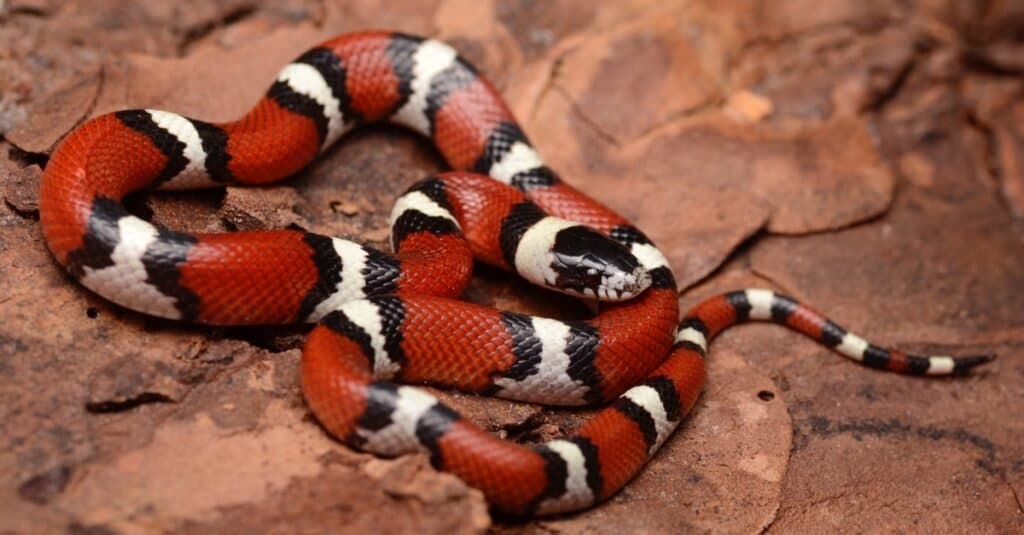
Milk snakes get their name from the false belief that these snakes milked cows.
©TheTexasNaturalist/Shutterstock.com
There are 24 subspecies of milk snakes, living in many different types of habitats. Milk snakes live in a few areas of Mexico, the Caribbean, central and eastern parts of the United States, and Southeastern Canada. These snakes are anywhere between 14-72 inches long, depending on the subspecies. For example, the New Mexico milk snake is 16-24 inches long, while the Andean milk snake can grow up to 72 inches long.
The appearance of milk snakes varies as much as their size does. Typically, however, all milk snakes have some combination of bright scarlet red, black, and cream or yellow coloring and banded or blotch-shaped markings. Black bands frame these white or cream markings. Because this bright coloring mimics the venomous coral snake, it helps to keep this red snake safe from predators. These snakes are nonvenomous and harmless to humans.
19. San Francisco Garter Snake
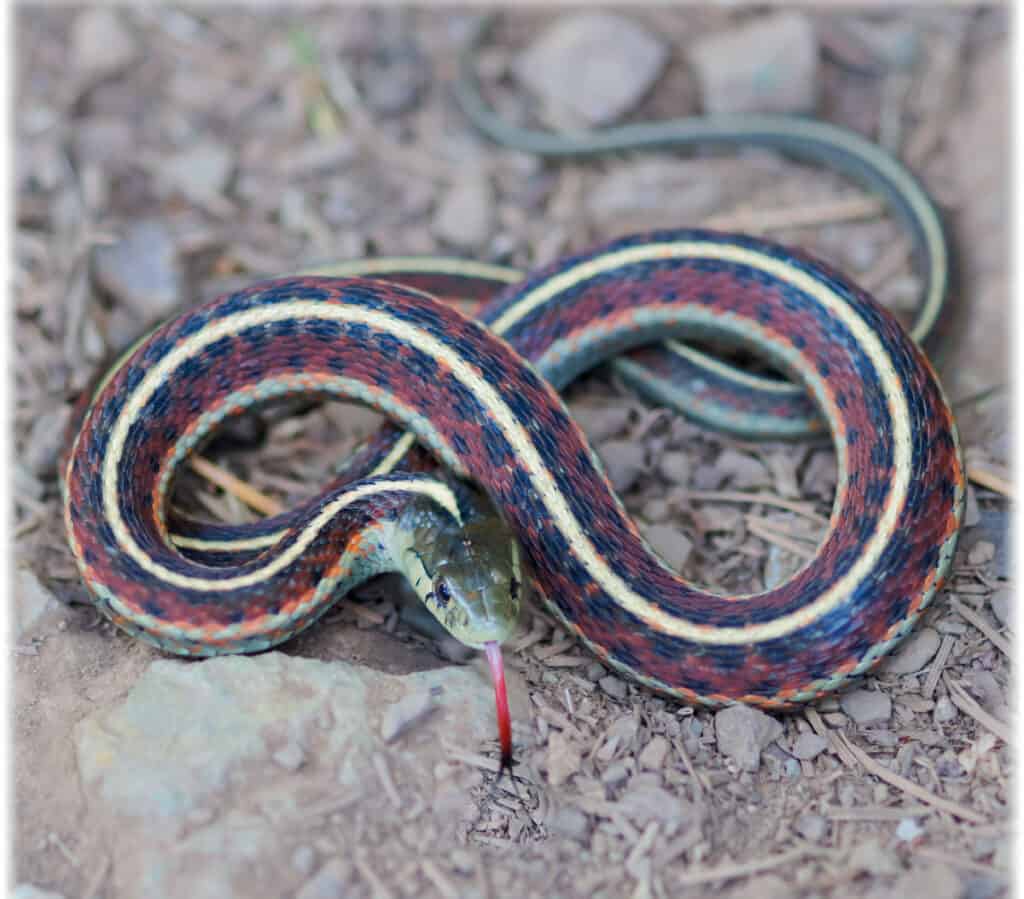
The San Fransisco garter snake is one of the rarest snakes in North America.
©iStock.com/yhelfman
The San Francisco garter snake lives on the San Francisco Peninsula in California, usually in moist and dense vegetation. Due to its habitat near ponds and other bodies of water, this snake primarily eats California red-legged frogs. It is a subspecies of the garter snake and grows 18-55 inches long. Additionally, this colorful snake has blue-green, black, and red stripes, and a small, red head. The nonvenomous San Francisco garter snake is an endangered species, due to habitat loss and illegal reptile collection.
18. Scarlet Snake
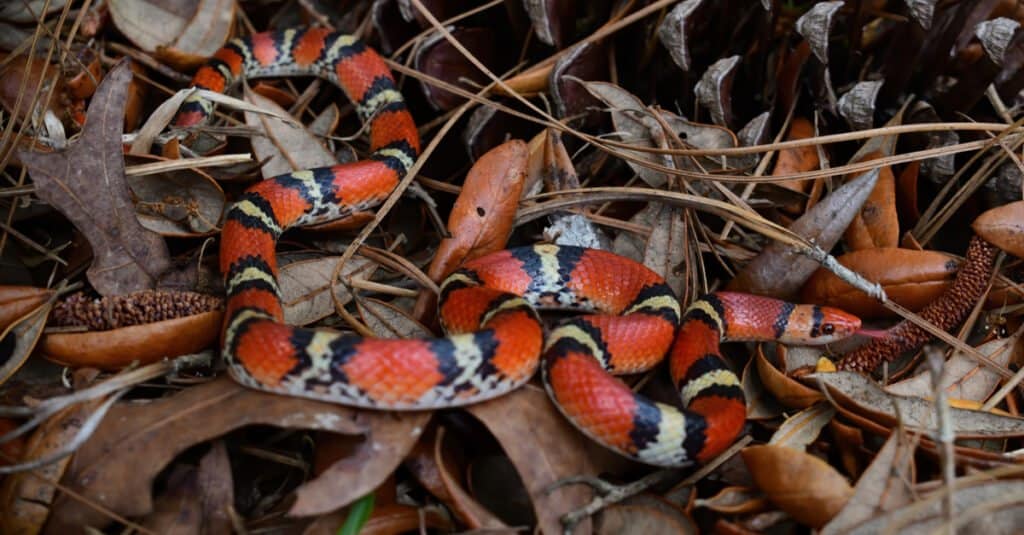
The scarlet snake is nonvenomous, even though it looks similar to the highly venomous coral snake.
©Chase D’animulls/Shutterstock.com
Scarlet snakes are usually found in open forests areas in the southeast United States. There are also a few isolated populations of scarlet snakes in Missouri and New Jersey. These are small, nonvenomous snakes that grow around 14-20 inches in length with thin bodies. They are white, beige, or gray, with large and long red splotch marks and smaller white or cream bands. Small black bands separate these red and white markings. Scarlet snakes are nocturnal and secretive, burrowing and hiding most of the day. They are rarely seen by humans.
17. Amazon Tree Boa
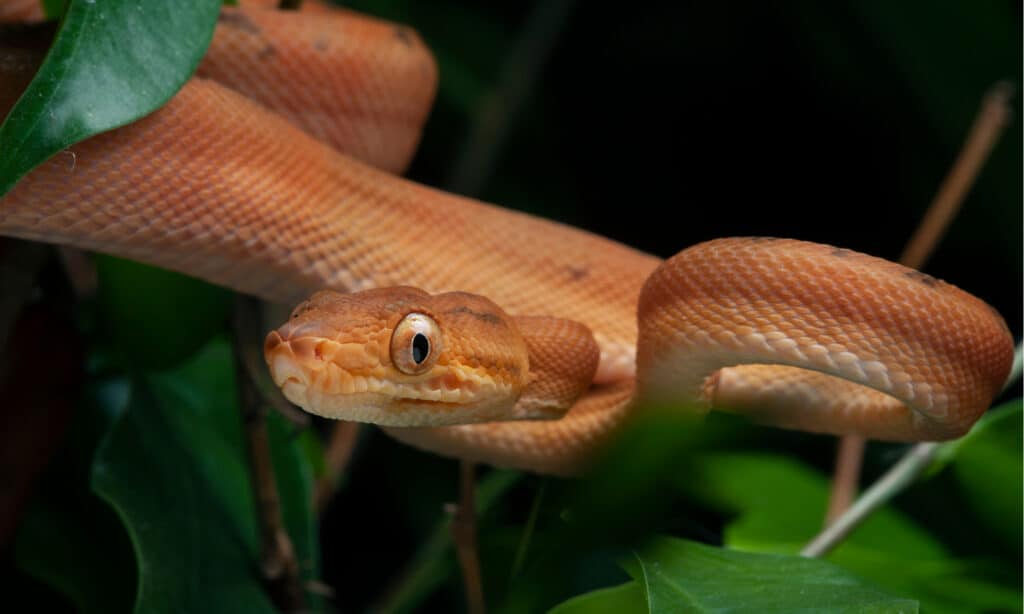
Amazon tree boas can have many different colors and patterns throughout their lives.
©Amazon Tree Boa/Shutterstock.com
The Amazon tree boa lives in the forests of South America. It is a stunning, nonvenomous snake that grows 4-6 feet in length. Amazon tree boas come in a wide range of colors, from black and dull brown to bright yellow, orange, and red. Some snakes are solid in color, while others have patterns on their backs. Each snake has its own individual coloring and design, so it is rare to find any two snakes that look the same. Although they are extremely beautiful, Amazon tree boas are very aggressive and bite easily with their long, sharp teeth.
16. Coral Snake
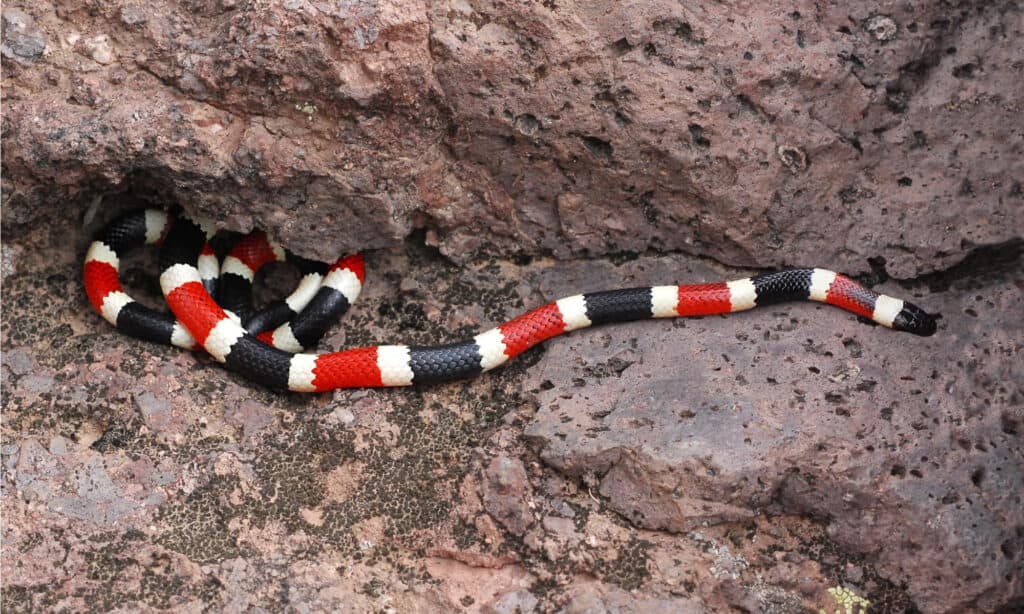
While many other venomous snakes have vertical, thin pupils, coral snakes have round pupils.
©jokerbethyname/Shutterstock.com
There are over 65 species of venomous New World coral snakes living in North and South America. In the United States, the common saying “red touches yellow, kills a fellow” is used to help people recognize which snakes are harmless and which are venomous. However, biologists now know that this saying is not always accurate, as there are some coral snakes living in other areas that have different patterns and coloring. In the United States, however, particularly in southeastern regions, the saying still holds true.
Coral snakes in the United States have yellow or white, red, and black bands. There are many snakes that have similar patterns that mimic the coral snake, but only coral snakes have red bands next to yellow or cream bands. Nonvenomous mimics, like milk snakes and scarlet snakes, have red bands touching black bands. Coral snakes are secretive and reclusive, spending much of their lives burrowed underground or hiding in leaf litter. Although these snakes have a toxic venom, they are not aggressive and rarely bite humans.
15. Scarlet Kingsnake

The snout of the scarlet kingsnake is always red, making it another easily identifiable feature.
©iStock.com/JasonOndreicka
The scarlet kingsnake lives in the east and southeast United States. Most commonly these snakes seem to prefer living in pine flatwoods. However, they have also been found in a wide variety of different habitats, from prairies to urban swimming pools. These nonvenomous snakes are typically 16-20 inches long with deep red bodies and black-bordered yellow bands. Scarlet kingsnakes are rarely seen by humans, as they are secretive and nocturnal, and often burrow underground.
14. Red Racer
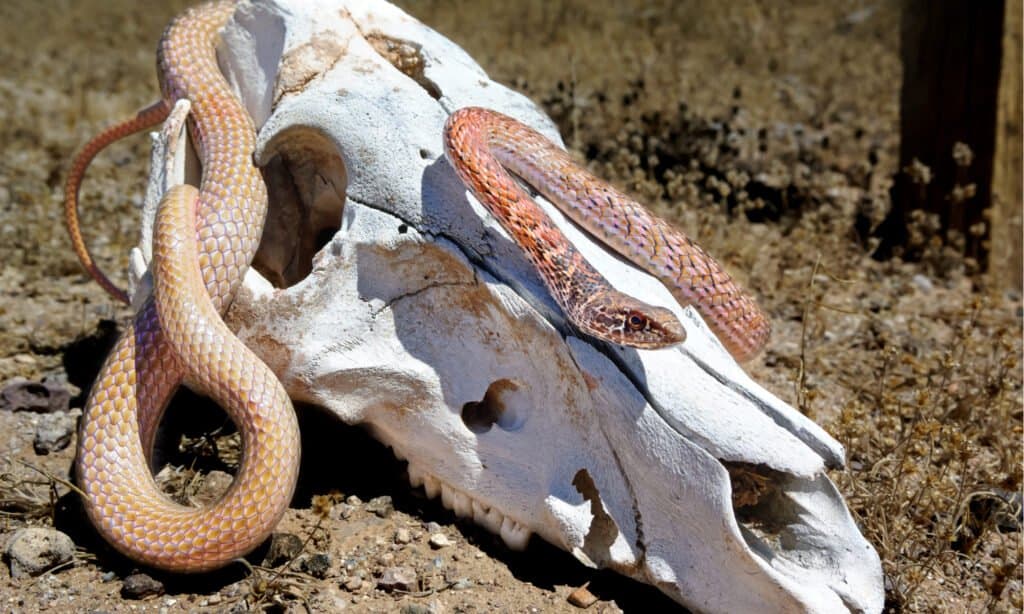
The red racer is also called the red coachwhip, because of the “whip”-like braided pattern of its tail.
©Deep Desert Photography/Shutterstock.com
The red racer, or red coachwhip, in a nonvenomous snake that lives in the Western United States and a few areas of Mexico. These snakes are found in open, rocky areas and deserts. Red racers grow to 36-102 inches in length with slender, whip-like bodies. Their bodies are pink, red, tan, or gray, with black bands or splotches on their necks and heads. As red racers age, their coloring transforms, becoming more and more red. Red racers are not venomous, but they are extremely aggressive. They are quick to attack and will violently bite when threatened.
13. Corn Snake or Red Rat Snake
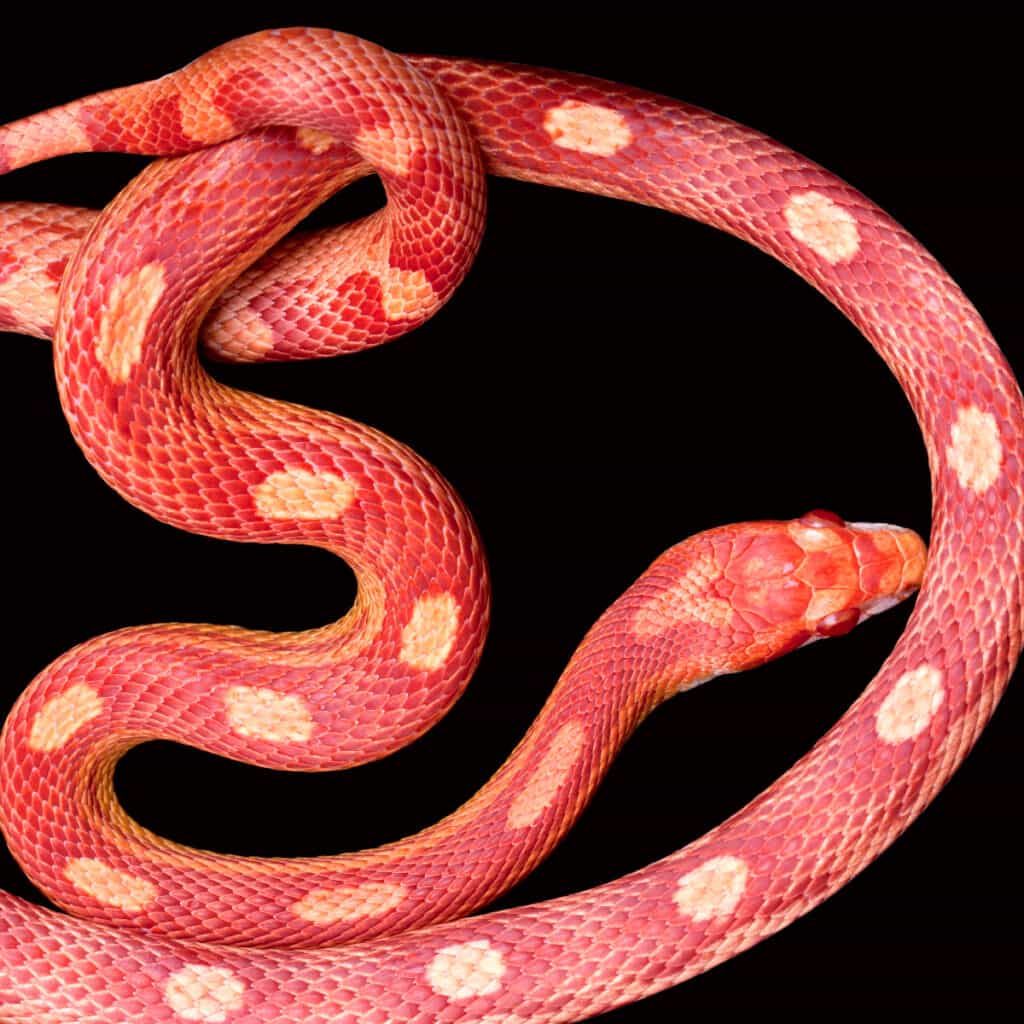
Corn snakes are one of the most popular pet snake species because they’re easy for beginners to handle.
©iStock.com/imarly
Did you know that corn snakes are a species of rat snake that live in the east and southeast United States? These snakes are typically 2-4 feet long, with brown, gray, tan, or orange bodies and red-orange spots or blotches framed in black along their backs and sides. Their name comes from the unique checker-board pattern on their bellies, which looks like maize or flint corn. Corn snakes are constrictors and eat a wide variety of animals, like mice, shrews, rats, birds and bird eggs, insects, reptiles, and amphibians.
These snakes are docile and nonvenomous and are a very popular pet in the United States. Pet corn snakes have been crossbred over time to create an even wider range of different color morphs. The vibrant blood red corn snake, for example, is completely red with little to no patterning. The pied-sided blood red morph is much more rare, with white along its sides and belly, and a vibrant red back. Candy cane corn snakes, on the other hand, look like a living red and white striped candy cane.
12. California Red-Sided Garter Snake
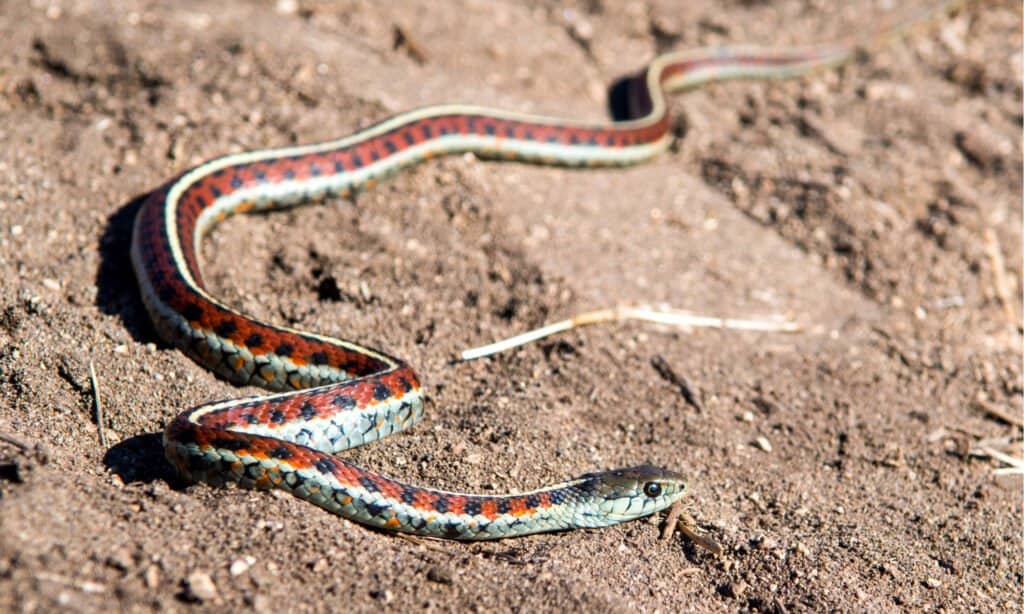
California red-sided garter snakes are 3 feet long on average.
©Simone O/Shutterstock.com
Like its name, the spectacular California red-sided garter snake lives in California, usually near water along the coast and marshy areas. These colorful snakes are found in the north in Humboldt County and Monterey County, and in the south between Santa Barbara and San Diego County. These red snakes are a subspecies of the garter snake, with very distinctive patterns and beautifully striking colors. Their bodies are checkered with vibrant red and black, with long, brightly contrasting yellow or blue stripes along their backs and sides. Whenever the snake slithers, these dazzling colors appear to hypnotically move as well.
California red-sided garter snakes grow 18-55 inches in length with slender, agile bodies. They do have a very mild venom used to attack their prey, but it is not deadly to humans. They will bite if they feel agitated or threatened, but in general these stunning snakes are good-natured. The California red-sided garter snake is an endangered species.
11. Mud Snake
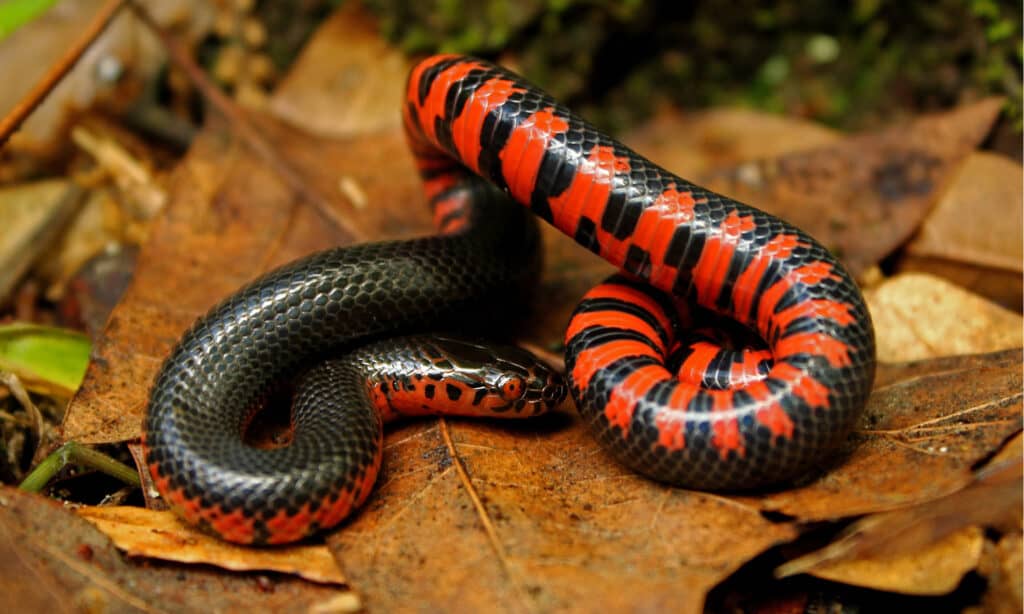
Of all the mud snakes, the longest one on record was more than 80 inches long.
©Thesigner_2696/Shutterstock.com
The mud snake is nonvenomous and lives in the southeast United States. The top of this red snake is completely black with sleek, glossy scales. Its underbelly and lower sides, however, are bright red with black striping. Mud snakes are 40-54 inches long with thick heavy bodies. These snakes are nocturnal and semi-aquatic, but they only leave the water to brumate and lay eggs. Mud snakes eat aquatic prey like amphibians and giant aquatic salamanders.
10. Red-Headed Krait
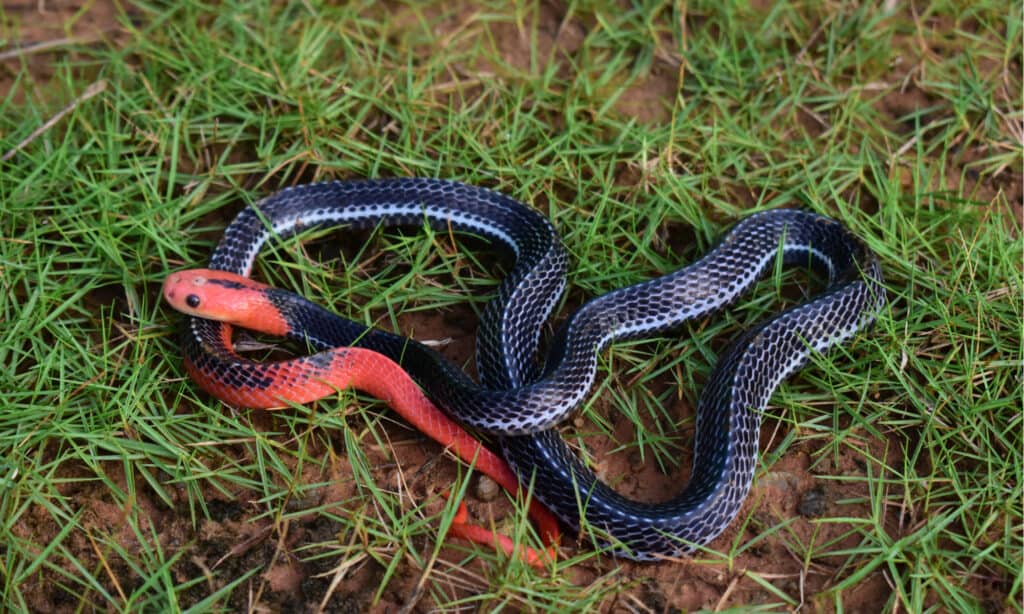
The red-headed krait is highly venomous and dangerous. However, this snake is rarely encountered.
©KritsadaPetchuay/Shutterstock.com
The red-headed krait is an enchanting and beautiful snake found in lowland rainforests and on islands of Southeast Asia. Although it can grow to 7 feet in length, this snake is usually closer to 4-5 feet long. What makes this semi-aquatic snake so dramatically striking is its bright red head and tail, sharply contrasted by its glossy black body. Very thin blueish-white stripes run along each side of the snake’s slender body as well. Red-headed kraits are extremely venomous and dangerous. However, these snakes are nocturnal and rarely bite. Red-headed kraits generally live far from human settlements as well.
9. African Bush Viper

African bush vipers come in variations of orange, red, gray, black, yellow, blue, brown and olive.
©iStock.com/Mark Kostich
The African bush viper is a venomous arboreal snake that lives most of its life high in the trees of West and Central Africa’s tropical rainforests. These snakes are 18-24 inches long and are sometimes called green vipers. However, the African bush viper comes in a vast array of colors and variations, including red, orange, yellow, blue, brown, green, black, and gray. As these snake age, their colors may continue to change. African bush vipers look like baby dragons with overlapping, keeled scales that give the snake a rather thorny appearance.
8. Red-Bellied Black Snake

Red-bellied black snakes are glossy black on the top and various shades of red on their underside.
©Ken Griffiths/Shutterstock.com
The red-bellied black snake lives in moist habitats in Australia, like lagoons, swamps, streams, woodlands, forests. These snakes are 48-72 inches long with shiny black, smooth-scaled bodies. Their lower sides are bright red, and fade into pink or orange bellies. Red-bellied black snakes primarily eat frogs, toads, and tadpoles. Unfortunately, this also exposes them to the cane toad, which is toxic to these snakes. Red-bellied black snakes are venomous, but they are not aggressive.
7. Red Spitting Cobra
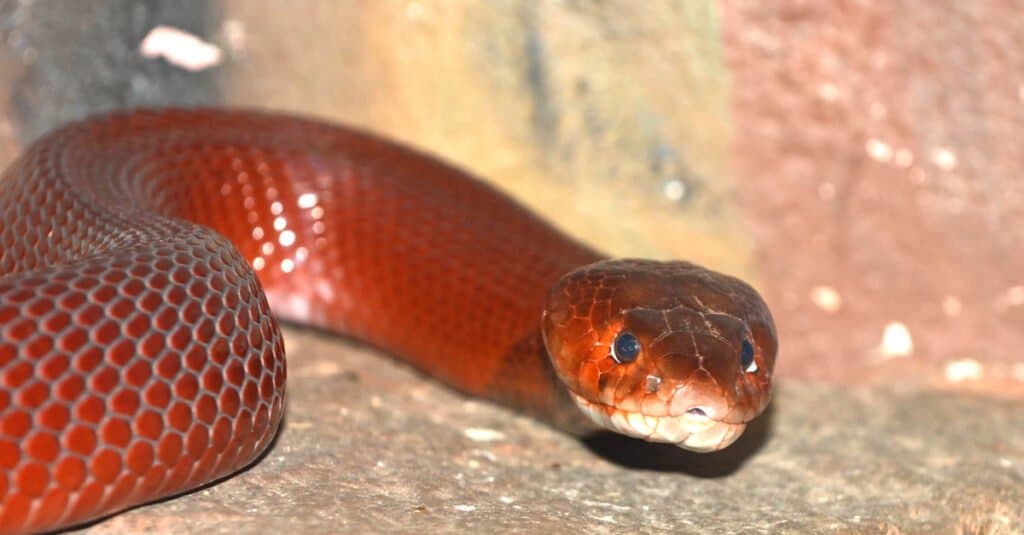
The red spitting cobra is a dangerous snake capable of spitting venom into its victims’ eyes.
©mountainpix/Shutterstock.com
The red spitting cobra lives in desert regions and near watering holes in East Africa and Kenya. This snake is typically red or orange with a large black or dark blue band encircling its throat. Depending on its home region, however, it may have brown, orange, yellow, pink, or gray color variations. The red spitting cobra is 28-50 inches long and gets its name from its distinctive defense. When threatened, the red spitting cobra literally “spits” its venom into the eyes of its assailant with astonishing accuracy.
6. Black-Headed Cat Snake

The black-headed cat snake has vertically split pupils that look like cat eyes.
©Pepew Fegley/Shutterstock.com
The black-headed cat snake, or red cat snake, lives in the tropical rainforests of southeast Asia. This arboreal snake is brown, black, red, or orange, growing to a length of 36-54 inches. Adult black-headed cat snakes also have a greenish-black head. These snakes are venomous, possibly similar to the toxicity of a copperhead snake. They eat smaller snakes, amphibians, lizards, rodents, and birds.
5. Ring-Necked Snake
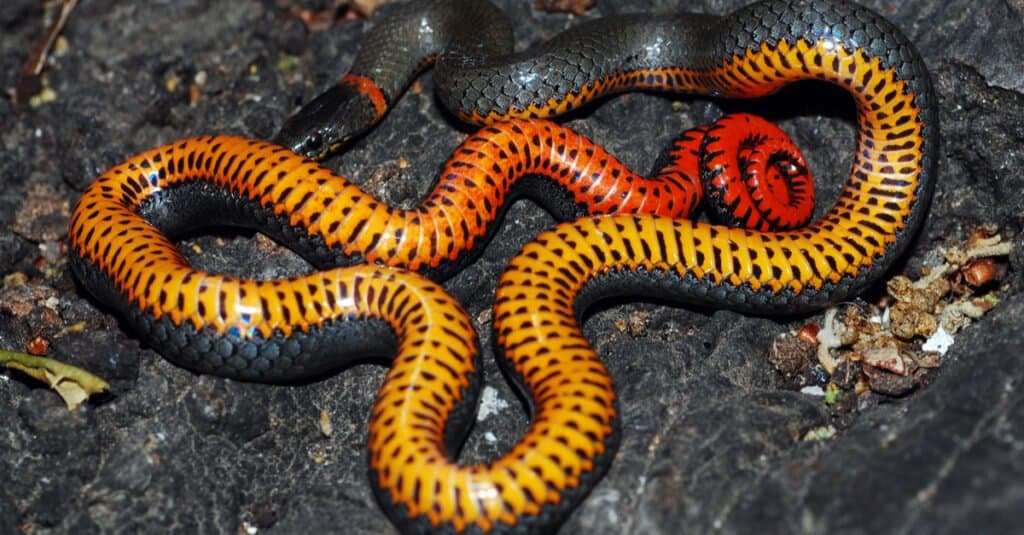
Ring-necked snakes will often play dead when threatened.
©Jason Mintzer/Shutterstock.com
The ring-necked snake is a small, harmless snake found in the United States, southeast Canada, and central Mexico. The top half of the snake’s body is black or grey, while the bottom half has vibrant shades of shades of red, orange, and/or yellow with tiny black spots. It also has a colored “ring” marking around its neck. When threatened, the ring-necked snake coils its tail to expose its bright underbelly. Although common, these snakes are secretive and rarely seen by humans.
4. Blue Malayan Coral Snake
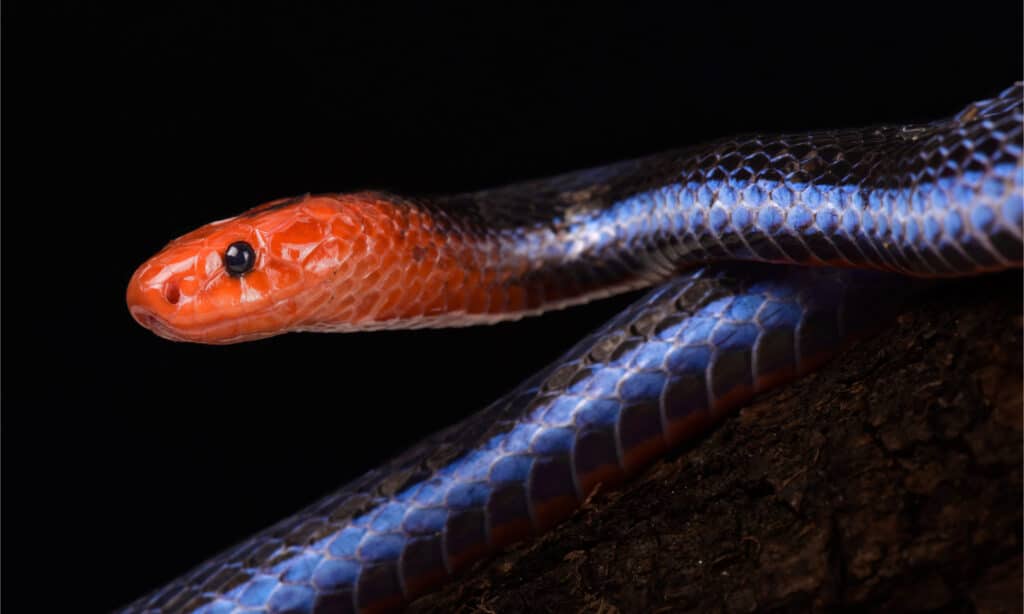
The blue Malayan coral snake is beautiful but deadly.
©reptiles4all/Shutterstock.com
Like its name, the blue Malayan coral snake is mostly blue or blue-black in color, often with a white or blue stripe along each of its sides. However, this snake has a dazzlingly bright red, belly, and tail, which contrasts brilliantly with its otherwise dark coloring. Blue Malayan coral snakes are very toxic venomous snakes in Southeast Asia that grow 55-70 inches long.
3. Red Coffee Snake
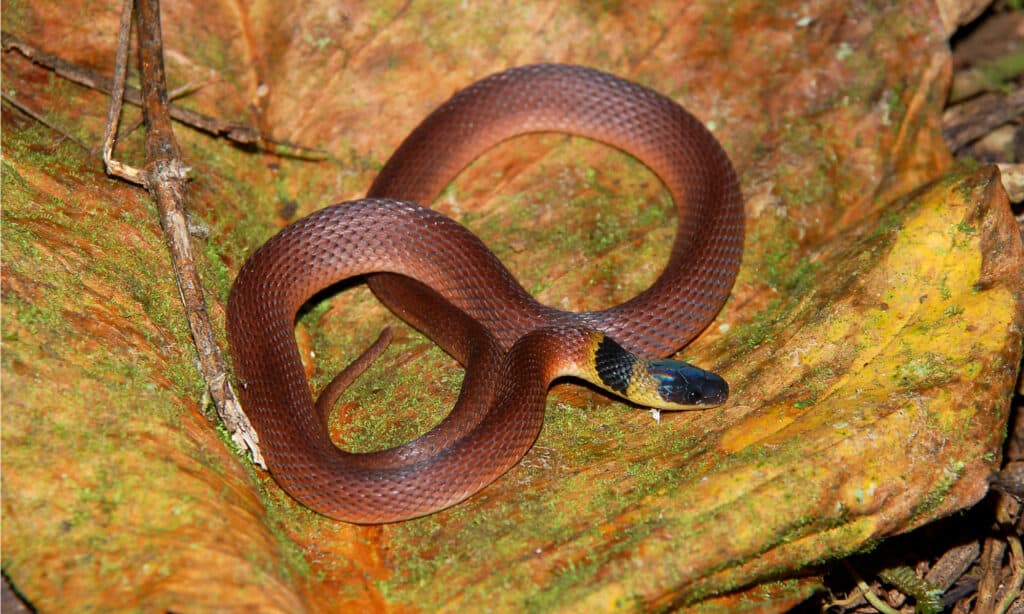
The red coffee snake lives across Central America and portions of Mexico.
©Ferdy Timmerman/Shutterstock.com
The red coffee snake is a nonvenomous snake that lives in savanna and forest regions of Central America and Mexico. These snakes are deep red with black and yellow patterned heads. Although they may be similar in color to venomous coral snakes, red coffee snakes are harmless. They eat earthworms, snails, and slugs.
2. Sumatran Blood Python
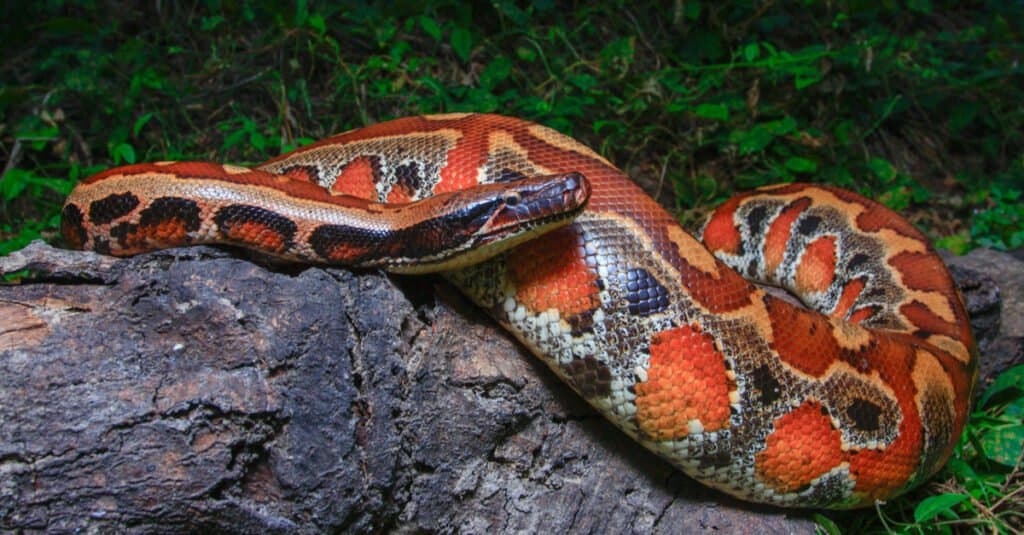
The adult blood python grows up to 8 feet in length. It can be heavy because of its muscular build.
©dwi putra stock/Shutterstock.com
The Sumatran blood python lives in rainforests and marshes in Southeast Asia. These snakes are typically 36-72 inches long with thick heavy bodies. Blood pythons are often bright red in color, although some are also orange, brown, or yellow. Lighter tan and yellow markings and stripes cover their bodies. Tragically, these nonvenomous snakes are often trapped and sold for leather due to their beautiful coloration. Blood pythons are aggressive and unpredictable, although some people do keep them as pets.
1. Red Coral Kukri Snake
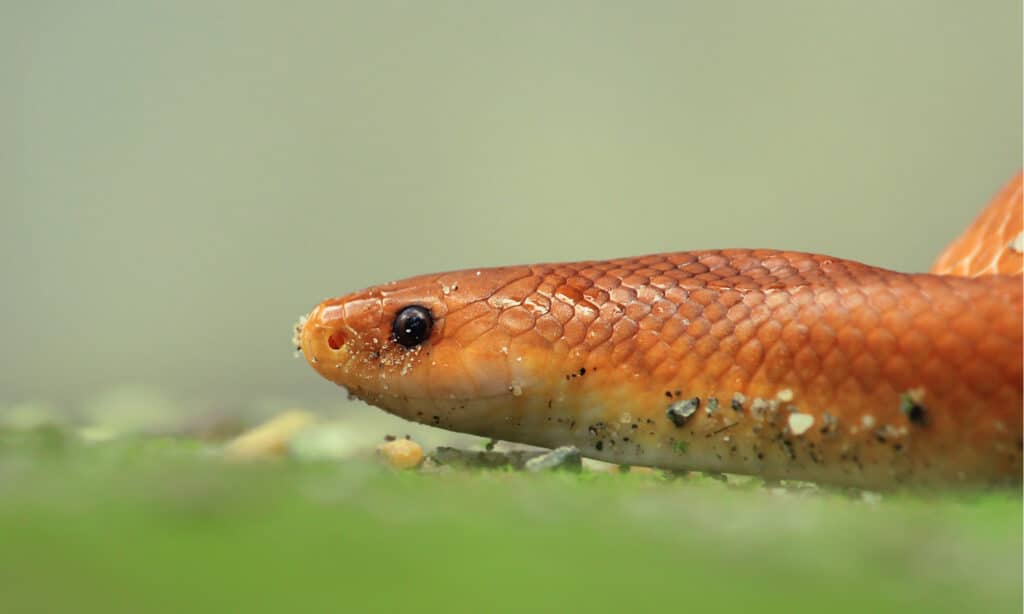
The red coral kukri gets its name from its large hind teeth that are curved like the Gorkha “kukri” knife.
©Prajjwal Ray/Shutterstock.com
Little is known about the extremely elusive red coral kukri snake. Most of the information we do know comes from only two of these snakes found in 2014 and 2015 in India. Both were deceased upon discovery. Only a small handful of these snakes have been sighted since the snake was first recorded in 1936. Now and again a single red coral kukri snake will be spotted momentarily in India, usually every few years or so. In 2021, one of these rare snakes was seen in Bangladesh for the first time.
Red coral kukri snakes are nonvenomous snakes with bright orange or coral red bodies. Biologists believe these snakes live underground and eat earthworms and insects. The red coral kukri snake is protected in India under the Wildlife Protection Act of 1972.
Bonus: The Red Diamondback Rattlesnake
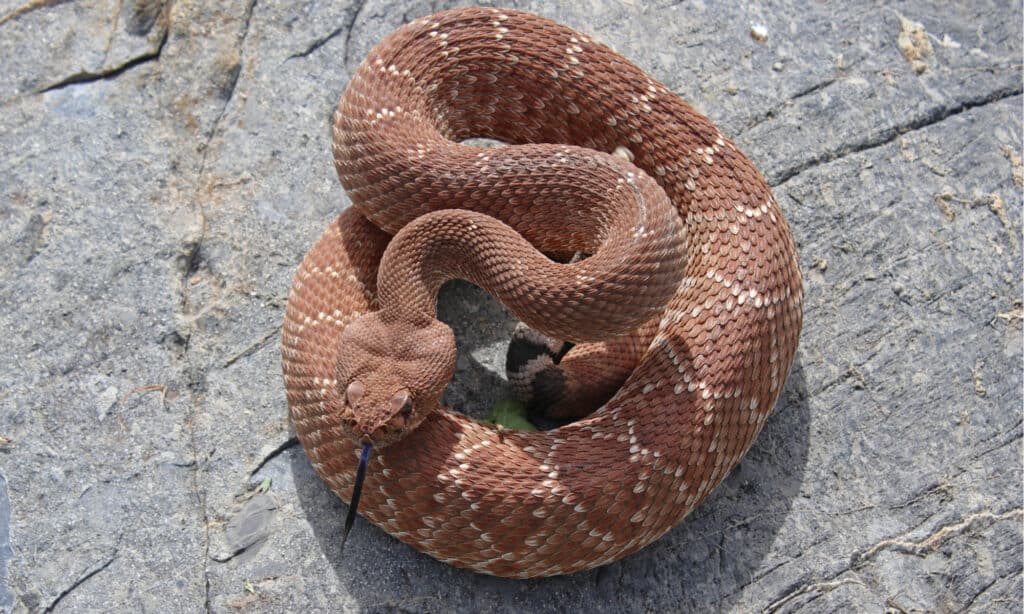
Red diamondback
rattlesnakes
coil up, rattle, and may strike when they’re threatened.
©Creeping Things/Shutterstock.com
You may not have realized that there is a variety of diamondback rattlesnake that occurs in shades of red. The red diamondback rattlesnake (Crotalus ruber) sports diamond-shaped blotches the length of its back with reddish tinges. Youths are grayer, becoming redder as they mature. Its tail has white and black bands that converge into its rattle.
This venomous snake is quite the looker, but you won’t witness it except in its native habitats of the Pacific islands of Cedros and Santa Margarita, several islands in the Gulf of California, and the southwest corner of California extending to the tip of the Baja Peninsula.
Summary of Incredible Red Snakes
Here’s a recap of the 20 red snakes:
| Number | Snake | Location | Type |
|---|---|---|---|
| 1 | Red Coral Kukri Snake | India, Bangladesh | Nonvenomous |
| 2 | Sumatran Blood Python | Southeast Asia | Nonvenomous |
| 3 | Red Coffee Snake | Central America, Mexico | Nonvenomous |
| 4 | Blue Malayan Coral Snake | Southeast Asia | Highly venomous |
| 5 | Ring-Necked Snake | U.S., Canada, Mexico | Nonvenomous |
| 6 | Black-Headed Cat Snake | Southeast Asia | Venomous |
| 7 | Red Spitting Cobra | East Africa, Kenya | Venomous |
| 8 | Red-Bellied Black Snake | Australia | Venomous |
| 9 | African Bush Viper | West and Central Africa | Venomous |
| 10 | Red-Headed Krait | Southeast Asia | Highly venomous |
| 11 | Mud Snake | Southeast U.S. | Nonvenomous |
| 12 | California Red-Sided Garter Snake | California | Mildly venomous |
| 13 | Corn Snake | East and southeast U.S. | Nonvenomous |
| 14 | Red Racer | Western U.S., Mexico | Nonvenomous |
| 15 | Scarlet Kingsnake | East and southeast U.S. | Nonvenomous |
| 16 | Coral Snake | North and South America | Venomous |
| 17 | Amazon Tree Boa | South America | Nonvenomous |
| 18 | Scarlet Snake | Southeast U.S. | Nonvenomous |
| 19 | San Francisco Garter Snake | San Francisco | Nonvenomous |
| 20 | Milk Snake | Mexico, the Caribbean, U.S., Canada | Nonvenomous |
The photo featured at the top of this post is © lisdiyanto suhardjo/Shutterstock.com
Discover the "Monster" Snake 5X Bigger than an Anaconda
Every day A-Z Animals sends out some of the most incredible facts in the world from our free newsletter. Want to discover the 10 most beautiful snakes in the world, a "snake island" where you're never more than 3 feet from danger, or a "monster" snake 5X larger than an anaconda? Then sign up right now and you'll start receiving our daily newsletter absolutely free.
Thank you for reading! Have some feedback for us? Contact the AZ Animals editorial team.






